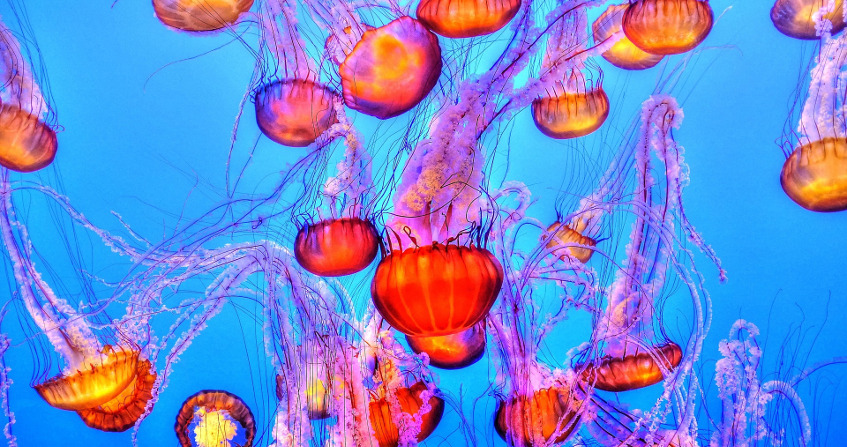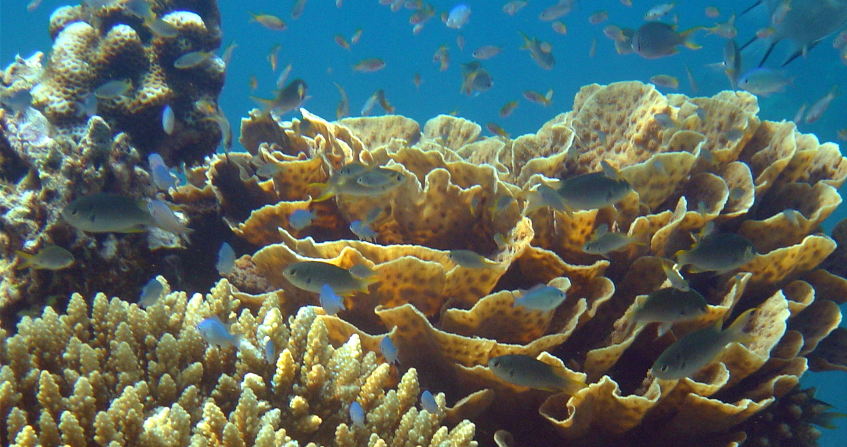Oysters: the little-known architects of coastal environments
PDF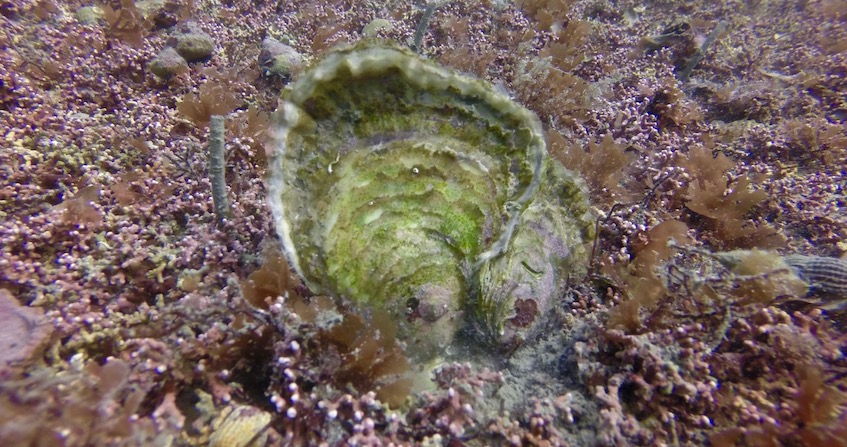
Oysters are essential marine invertebrates in our coastal ecosystems. These architects of the environment provide many ecosystem services while supporting a flourishing economic activity that structures coastal landscapes. For several million years, they have been responsible for the construction of thick layers of sedimentary rock that are essential to the planetary balance and demonstrate their formidable biogenic capacities. But with the Anthropocene, these geological behemoths are facing relentless overexploitation, habitat destruction, disease introduction, global warming and pollution of all kinds. A bit like the bee in the terrestrial environment, but less photogenic, this engineer species is really a keystone of the marine environment, but it is threatened and should be given more attention. “In his fable about the rat and the oyster, La Fontaine was right: we could well become the ultimate victim of this unbridled decline in biodiversity.”
1. The oyster: this essential and threatened marine invertebrate
There are two species of oysters in France: the flat oyster, Ostrea edulis, [1] native to our European coasts, and the Pacific cupped oyster, Crassostrea gigas, introduced 50 years ago to save French oyster farming (see Focus: A history lesson). Even if their origin, history, ecology and habits are different, these two species share common destinies: their essential role in the balance of the ecosystem and the same fragility in the face of anthropic pressures (Read The oyster, this sentinel witness of a coastline to preserve).
1.1. Two oyster species, two different biological models
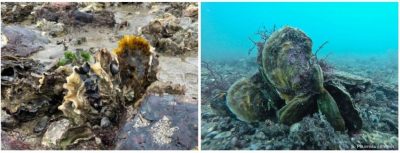
Original reproduction. Like most bivalve molluscs, oysters have a bentho-pelagic life cycle comprising:
- a free larval phase in the water column (referred to as the pelagic phase) lasting a few weeks;
- a sessile benthic phase (fixed on the bottom) for the rest of their lives.
They are hermaphroditic, either alternatively during their existence for the Pacific oyster, or consecutively at each reproduction season for the flat oyster. On the other hand, they always start their first reproduction with a male phase, which is called protandry.
Pacific oysters are said to be oviparous because they release their gametes into the water where fertilization then takes place, whereas flat oysters are viviparous!
In summer, the males of O. edulis release spermatozoa, grouped in a ball [2]. This gives them a selective advantage because it avoids a too fast dispersion of gametes. They are then filtered by the neighbouring females: the fertilization of the oocytes takes place in their mantle cavity and the larvae develop there for about ten days under cover. The flat oyster is an incubating species, a very rare characteristic among molluscs, which constitutes a second evolutionary advantage. During this incubation period, the offspring grows and the mother oyster passes from the “white-sick” stage when the larvae are just formed to the “grey/black-sick” stage when the larvae have acquired their first shell and are then ready to be released into the wild, at the mercy of the currents [3].
In French latitudes, the swarming of flat oyster larvae generally begins in June on the Atlantic coast. This seasonal phenological event is well known by Breton oyster farmers:“when the chestnut trees are in bloom, oyster farmers put down their collectors“. The Pacific oyster is a little more demanding in terms of temperature, and its spawning on the Atlantic coast does not take place before mid-July. To put it simply, we could say: St John’s Day for the flat oyster and July 14th for the Pacific oyster! But the climatic conditions of the current year can advance or delay this precision clock and the climate change already causes unpredictable jolts on the delicate mechanism [4].

The first year of a juvenile oyster’s benthic life is then full of pitfalls, between the search for a stable habitat, competition with other neighbouring organisms, daily predation, endemic and emerging viruses and parasites…
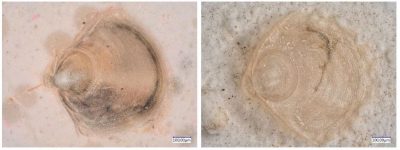
- An optimal nutrition. Oysters feed by filtering matter suspended in the water column from which they extract phytoplankton. An adult oyster can filter between 5 and 10 litres of water per hour from which it retains particles larger than 4-5 µm. Spring is the season when oysters fatten, grow and put a lot of energy into their reproduction: the phytoplankton must therefore be rich and diversified at this time [6].
- Specific physico-chemical conditions : optimal salinity (30 – 35 PSU), minimum water temperature in winter around 6°C and maximum in summer around 28°C, water with little turbidity rarely above 50 mg/L of suspended matter [7].
- A particular distribution. The two species share the coastal environment equally: the Pacific oyster lives in the tidal zone, whereas the flat oyster prefers the lower foreshore and shallow waters between 0 and 5 metres; it becomes rare beyond a depth of 10 metres.
In these optimal conditions, growth is continuous throughout the life of the animal, oysters can exceed 20 cm and have longevities of several decades: the record for a flat oyster in Wales is 34 years!
1.2. Ecology lesson: strength in numbers
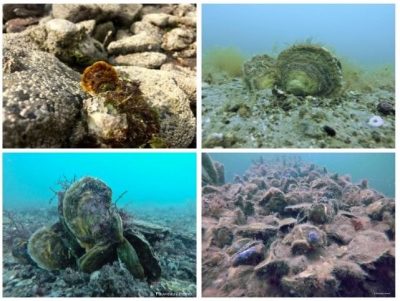
These builder organisms, known as “ecosystem engineers“, thus construct their own habitat. According to the Natura 2000 network classification [8], the habitat created by oysters is called “biogenic reef” (Habitat 1170). These reefs are real underwater mini-forests providing habitat, protection and food to many other marine species. They also work to keep the ecosystem clean and resilient. But the process is slow, much like that of corals: it takes years, even decades (Figure 4).
If Pacific oyster reefs are very present on our coasts, 50 years after the introduction of the species, flat oyster beds and reefs (the native species) constitute a critically endangered marine habitat on all European coasts [9]. Originally, these reefs constituted vast underwater expanses in all European seas, but they have almost disappeared after 4 centuries of relentless exploitation. They were called “Oyster Ground” in English or “Huitrières” in French. It is surprising to note that these terms have disappeared from our language over the generations and their destruction (Figure 5). (See Biodiversity on rocky coasts: zonation and ecological relationships).
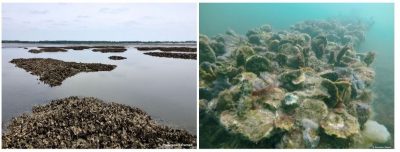
Currently, the reef aggregations of O. edulis, the first stage in the creation of these ancient reefs, can still be observed, in a sheltered and unexploited environment, on small loose bottoms (0-10 m deep) made up of sandy-muddy sediments, gravels, shellfish debris or directly on boulders. Under geographical protection, biological rest and active restoration, these biogenic reefs can become flourishing again and particularly rich in biodiversity (see below).
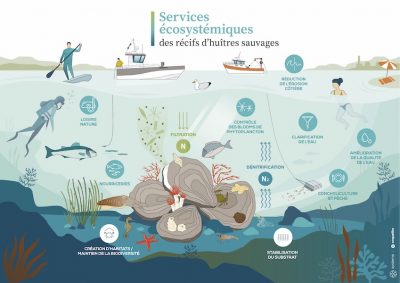
They can be grouped into 4 main categories:
- support services : creation of habitats and maintenance of marine biodiversity:
- The hard substrate of the shells allows the attachment of many sessile benthic organisms: bryozoans, tunicates, sponges, annelids, macro-algae settle there generously (Figure 7). [10]
- This canopy provides a refuge for many invertebrates (gastropods, bivalves, small crustaceans, echinoderms) and this swarming attracts small pelagic organisms (fish and cephalopods) from the surroundings. All these organisms feed and lay their eggs there. The reefs thus play essential roles as nurseries and feeding grounds.
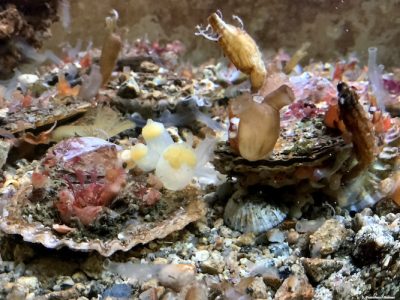
- regulation services : But their engineering skills do not stop there:
- These biogenic massifs play the role of powerful biological filters which, without respite, purify the water column of all suspended matter (good or bad) and actively contribute to the regulation of natural biogeochemical cycles: filtration, denitrification, purification, clarification 24 hours a day. They are the “pump and filter of the aquarium” in coastal environments, discreet, silent, hard-working and essential…
- Moreover, their cohesive structures also allow the stabilization of sediments, the attenuation of waves energy and the reduction of laminar bottom currents. These physical barriers structure coastal and underwater landscapes and encourage the nearby installation of more fragile habitats and/or those requiring clear water, notably eelgrass and maerl beds.
- production services :
- Food products used by humans (fishing and aquaculture);
- Raw shellfish materials for agriculture (limestone amendment) and now for industry (Oysterprene®, kaolin and glass made from oysters, shellfish concrete, Geocorail®, etc.).
- cultural services : finally, a bit like wine and vineyards, oysters contribute to ecotourism (oyster road, oyster festival and even oyster trail!), diversifies and enhances coastal landscapes and supports recreational activities (diving, fishing) but also educational activities (educational marine areas).
2. Geological colossus with feet of clay in the face of climate change
If the recruitment of young oysters fails several times in a row, the population declines and may disappear, especially if other unfavourable factors are involved, such as multiple and varied anthropogenic pressures. In this particular case of species-ecosystem engineers, the cascading repercussions affect distribution, community structure, biodiversity and sometimes the entire ecosystem. On the other hand, as soon as conditions become favourable for larval life and recruitment, the high individual fecundity characteristic of these species is an asset that can help them to reconstitute new populations fairly quickly, especially if humans help them a little.
2.1. Identified and manageable local threats
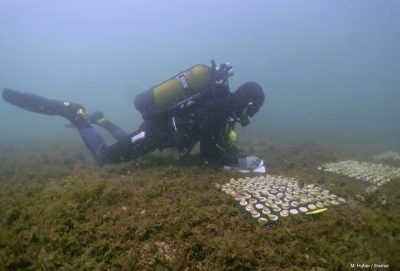
By combating these identified threats that can “easily be acted upon” locally and by providing biological rest areas, certain underwater habitat restoration policies can be envisaged to promote the recovery of former flat oyster beds and thus make the ecosystem more resilient (see 3.2).
2.2. A global, insidious and uncontrollable threat
Among the more global threats is of course that of chronic pollution (see article 2), but above all that of global warming and ocean acidification.
The ocean absorbs more than 90% of excess heat and more than 30% of atmospheric carbon dioxide (CO2) emissions. It therefore plays an essential role in regulating the global climate. The downside is that the surface ocean (0-300 m) has warmed by about 0.11°C per decade since 1971. At the same time, CO2 is interacting with seawater, turning into carbonic acid and slowly causing “ocean acidification”, the dangerous companion of climate change.
According to the most pessimistic scenario of the Intergovernmental Panel on Climate Change (IPCC; RCP 8.5), the temperature could increase by about 4°C by the end of the century and the pH (hydrogen potential) of the global ocean, currently 8.1, could decrease by another 0.32 units, which would correspond to an increase in its acidity of 110%. These changes have a direct impact on the biology of the oyster.
Oysters facing ocean warming. As an ectothermic animal, the oyster does not regulate its internal temperature and depends on the thermal conditions of its environment. The flat oyster initiates its reproduction as soon as the water masses exceed 17°C, the Pacific oyster waits for 18-19°C. For both species, the warmer water in summer favours larval development:
- The “Breton heat waves” are currently favourable to the reproduction of the flat oyster and could therefore facilitate future ecological restoration operations.
- From a biogeographical point of view, 50 years after its introduction, rreproduction of the Pacific oyster is now possible almost everywhere in Europe… as far as Norway. This represents a movement of 1400 km northward from its point of introduction in France [13]. Thus, in bay of Brest, spawning and survival of the offspring are now facilitated, and biological modelling exercises for 2100 [14] even indicate that there could be two spawning periods, an early and a late one in this temperate ecosystem where the oyster was not supposed to reproduce at the time of its introduction.
So on the Atlantic coast, we could say that until then, for these two species, all is well.
But on the Mediterranean coast, the heat waves of the last few years are worrying scientists a little more. Thus, in the Thau lagoon – the main oyster farming site in the Mediterranean – during the 2018 and 2019 heat waves, the water reached a record salinity of 42 PSU and a temperature approaching 30°C associated with a drop in dissolved oxygen concentrations in the water [15]. Very close to the physiological limits of the Pacific oyster, these conditions destabilize the benthic biocenoses and modify the planktonic communities on which the oyster feeds. For example, they favour very small species that tolerate these large environmental variations. However, these planktonic species are of no nutritional interest to the oyster, thus causing a halt in their growth, weight loss and increased mortality [16]. Here, climate change is a direct threat to oyster farming!
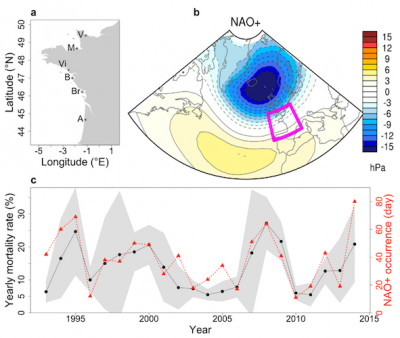
Oysters facing ocean acidification. An increase in water acidity reduces the availability of calcium carbonate, which is an essential mineral brick used by calcifying organisms, such as oysters, to build their shells. Severe acidification could even lead to the dissolution of these shells. Nearshore waters, populated by our favourite shellfish, are naturally more acidic and variable in pH than the open ocean, but they could become increasingly and permanently so. Currently, oysters are already sometimes confronted with pH levels of 7.7 in the Brest harbour.

The repercussions of pH on the flat oyster (native, which lives permanently in the water), which is already very fragile, are not well known.
On the other hand, for both species, the larval stage could be a much more sensitive phase: for example, in C. gigas larvae, a slowing down of growth and a decrease in survival are observed as soon as the pH goes below 7.6. This critical value has already been reached in some regions of the world, such as on the west coast of the United States, where scientists and shellfish farmers have shown a strong correlation between water acidity and mortality of Pacific oyster larvae [20], forcing them to develop strategies to adapt to it.
3. Reconciling conservation, ecological restoration and uses
3.1. A national observatory to anticipate the effects of climate on the oyster
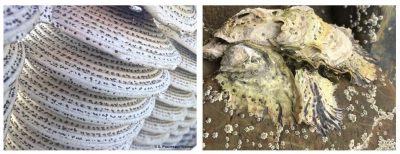
3.2. A global approach and a European alliance to save the flat oyster
Climate change is having a growing impact on ecosystems, but the erosion of biodiversity and the increased degradation of environments are reducing their resistance and making them even more fragile. Alongside measures to reduce CO2 emissions, nature-based solutions (NBS) offering greater resilience are also proving to be complementary responses.
The degradation of the seabed, the mechanization of fishing, pollution, massive soil erosion and increased sedimentation of estuaries, not to mention the introduction of allochthonous species that are sometimes invasive or pathogenic, are causing native species and their habitats to decline or disappear (see The oyster, the sentinel of a coastline to be preserved). In such a context, conservation biology and restoration ecology have also become essential multidisciplinary research topics in the marine environment, especially since the European Habitat Directive in 1992.

In France, the flat oyster, the only native and endemic oyster in Europe, has long been overlooked by the environmental code. Since 1992, the European Directive on Habitats, Fauna and Flora provides for “maintaining a favourable state of habitats or even restoring them” and since 2008, the OSPAR Convention [22] (Oslo-Paris) lists flat oyster reefs as a “critically endangered” habitat. However, in 2021, the ecological restoration of this species and its habitat is still in its infancy, but things are moving a little [23].
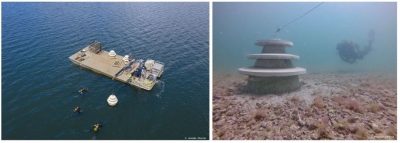
Some pioneering scientific projects in Brittany and Corsica have started to bear fruit in recent years [23] (Figure 13). In addition, a recently established European-wide alliance (NORA – Native Oyster Restoration Alliance) is also becoming increasingly active on these restoration issues [24]. This craze is expected to grow from 2021 onwards as part of the United Nations Decade on Ecosystem Restoration (UNDER). Gradually, the flat oyster, in the twilight of its existence, could become a real mascot, a pioneer ambassador of restoration ecology in the marine environment.
4. Messages to remember
- Oysters, which have been present on our coasts for millions of years, could well be added to the list of species threatened by man;
- These marine organisms, not very photogenic, reveal a biology much more complex than it seems, in particular in their strategy of reproduction, which enables them to quickly colonize an environment when the conditions are favorable;
- Oysters play a role as architect species, ecosystem engineers, biodiversity supports and suppliers of numerous regulation services (biological filters purifying the water column, stabilizing sediments, structuring coastal and underwater landscapes);
- The resilience that these biogenic fortresses bring to the marine environment is a valuable tool for adaptation and mitigation to the pressures of climate change.
- Continued globalisation will favour the emergence of new pathogens, parasites and predators, and the inherent inertia of the climate machine will have age-old repercussions on the maintenance of oyster ecosystems;
- In this context, the pragmatic solution of protecting, or even restoring, part of the surface of the globe (a golden figure of around 30% by 2030 [25]) is an objective that can easily be transposed to our coastal environments, and one that is easy enough to understand collectively and to consolidate together in order to maintain regional and planetary integrity;
- The active restoration of oyster beds is part of a whole, of a future strategy, that of nature-based solutions [26] promoted by the IUCN;
- Just like the bee in terrestrial environment, the polar bear in polar environment, the coral reefs in tropical environment, the oyster plays the role of a victim, a sentinel and an alerting agent for the coastal environment of our temperate latitudes. We just have to “listen to it” to avoid being “caught who thought he was caught”.
Notes and References
Cover image. Fragile reef colony of flat oyster in the heart of a former oyster beds destroyed in the 19th century and now being renatured in bay of Brest [Source: © IFREMER / Stéphane Pouvreau]
[1] The flat oyster, Ostrea edulis, is locally called Belon (southern Brittany), Gravette (Arcachon) or Pied de Cheval (for the wild ones that have grown).
[2] These structures are called “spermatozeugmata”; SUQUET, M. et al. (2018). Biological characteristics of sperm in European flat oyster (Ostrea edulis). Aquatic Living Resources, 31, 20 (7p).
[3] Duchene, J., Bernard, I., Pouvreau, S. (2015). Vers un retour de l’huître indigène en rade de Brest. Espèces, 16, 51-57.
[4] Pouvreau, S. et al. (2021). Inventaire, diagnostic écologique et restauration des principaux bancs d’huitres plates en Bretagne : le projet FOREVER. Ifremer. Rapport Final. Contrat FEAMP 17/ 2215675.
[5] Petton, S., Pouvreau, S., Dumas, F. (2020). Intensive use of Lagrangian trajectories to quantify coastal area dispersion. Ocean Dynamics, 70, 4, 541-559 .
[6] Bernard, I., De Kermoysan, G., Pouvreau, S. (2011). Effect of phytoplankton and temperature on the reproduction of the Pacific oyster Crassostrea gigas: investigation through DEB theory. Journal of Sea Research, 66, 349-360.
[7] Especially for the flat oyster, which does not appreciate turbidity or sedimentation.
[8] http://www.natura2000.fr/outils-et-méthodes/guides-ouvrages/cahiers-habitats
[9] Pouvreau, S. et al. (2021). Current distribution of the residual flat oyster beds (Ostrea edulis) along the west coast of France. SEANOE. https://doi.org/10.17882/79821
[10] The shell of the flat oyster is particularly flaky and offers a support capacity four times richer than a standard mineral hard substrate but also twice as rich as its introduced cousin.
[11] Bosseboeuf, L. (2019). Étude de la variation des ressources marines en rade de Brest : 1866-1963. HistoRade project. Univ. Bretagne Occidentale, Master 2 report. 80p.
[12] Oyster drills are destructive winkles (small gastropods) that bore holes in the shells of bivalves to feed on their flesh. The action of their rasping tongue combined with the secretion of enzymes allows them to drill a small circular hole in a few hours (or even two days for the thickest shells). There was a native species, the cormaillot Ocenebra erinacea, but the two species introduced during the 20th century, Urosalpinx cinerea and especially Ocinebrellus inornatus, are much more voracious.
[13] Thomas, Y. et al. (2016). Global change and climate-driven invasion of the Pacific oyster (Crassostrea gigas) along European coasts: a bioenergetics modelling approach. Journal Of Biogeography, 43, 3, 568-579.
[14] Gourault, M. et al. (2019). Modeling reproductive traits of an invasive bivalve species under contrasting climate scenarios from 1960 to 2100. Journal of Sea Research 143, 128-139
[15] Fleury, E. et al. (2020). Observatoire national du cycle de vie de l’huître creuse en France – Année 2019. Rapport Annuel de Contrat Convention DPMA – Ifremer. 71 p.
[16] Lagarde, F. et al. (2021). Phénomène d’Eaux Vertes à Picochlorum en lagune de Thau pendant les années 2018 et 2019, Observations environnementales. RST Ifremer ODE/UL/LERLR21/15. In press
[17] Thomas, Y., Cassou, C., Gernez, P., Pouvreau, S. (2018). Oysters as sentinels of climate variability and climate change in coastal ecosystems. Environmental Research Letters 13, 104009 (12p.)
[18] Merou, N. (2021). Étude de l’écologie de Marteilia refringens et Bonamia ostreae, deux parasites protozoaires de l’huître plate, Ostrea edulis. Thesis Univ. La Rochelle. 246 p.
[19] Lutier, M. et al. (2021) Revisiting tolerance to ocean acidification: insights from physiological, biochemical, and molecular tipping points of a marine calcifier. in prep.
[20] Barton, A. (2012). The Pacific oyster, Crassostrea gigas, shows negative correlation to naturally elevated carbon dioxide levels: Implications for near-term ocean acidification effects. Limnology and Oceanography 57, 698-710.
[21] VELYGER: http: //wwz.ifremer.fr/velyger
& Growth and Survival Network (RESCO): https: //wwz.ifremer.fr/observatoire_conchylicole/
[22] The Convention for the Protection of the Marine Environment of the North-East Atlantic or OSPAR Convention (OSPAR for “Oslo-Paris”) sets out the arrangements for international cooperation for the protection of the marine environment of the North-East Atlantic. It entered into force on 25 March 1998, and replaces the Oslo and Paris Conventions. https://www.ospar.org/
[23] ANONYMOUS (2018). Document stratégique de la façade Nord Atlantique – Manche Ouest. Annexe 6 : objectifs stratégiques et indicateurs associés. Rapport Direction inter-régionale de la mer Nord Atlantique-Manche Ouest. 295 pp.
[24] Pogoda, B. et al. (2019). The Native Oyster Restoration Alliance (NORA) and the Berlin Oyster Recommendation: bringing back a key ecosystem engineer by developing and supporting best practice in Europe. Aquatic Living Resources, 32, 13 (9p).
[24] Sala E. et al. (2021) Protecting the global ocean for biodiversity, food and climate. Nature. 592, pages 397-402
[26] https://uicn.fr/solutions-fondees-sur-la-nature/
The Encyclopedia of the Environment by the Association des Encyclopédies de l'Environnement et de l'Énergie (www.a3e.fr), contractually linked to the University of Grenoble Alpes and Grenoble INP, and sponsored by the French Academy of Sciences.
To cite this article: POUVREAU Stéphane, DI POI Carole, FLEURY Elodie, LAGARDE Franck (December 10, 2021), Oysters: the little-known architects of coastal environments, Encyclopedia of the Environment, Accessed December 22, 2024 [online ISSN 2555-0950] url : https://www.encyclopedie-environnement.org/en/life/oysters-little-known-architects-of-coastal-environments/.
The articles in the Encyclopedia of the Environment are made available under the terms of the Creative Commons BY-NC-SA license, which authorizes reproduction subject to: citing the source, not making commercial use of them, sharing identical initial conditions, reproducing at each reuse or distribution the mention of this Creative Commons BY-NC-SA license.





